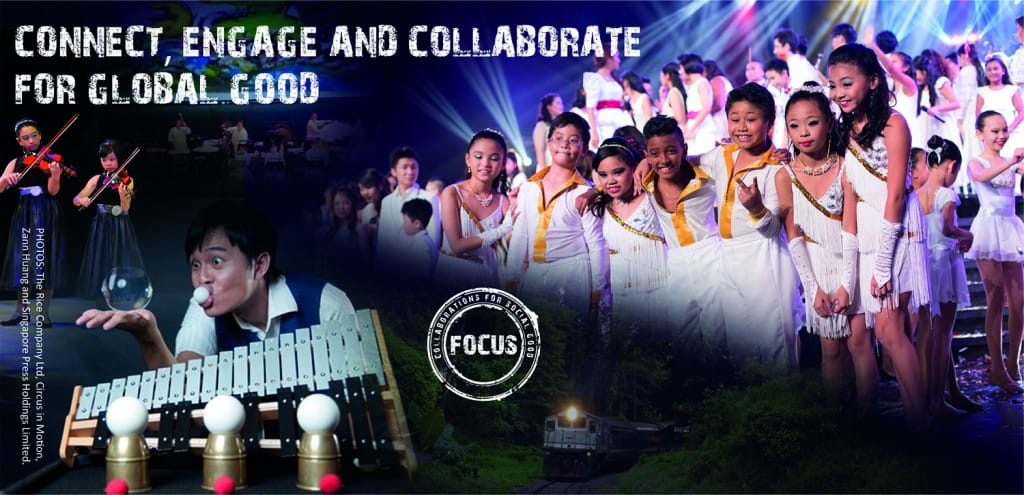
ChildAid performers put their talent to use, raising funds for less privileged children through their concerts, while Jay Che, from social circus troupe Circus In Motion, performed at the Basheradis Festival in Italy in 2012, doing tricks such as juggling ping pong balls and using them to play the xylophone.
DiverseCity 2014, Singapore International Foundation’s biennial cultural relations showcase, returns bigger and better, celebrating the role of artists and cultural leaders as citizen ambassadors in promoting understanding between Singaporeans and world communities while building a global network of friendship.
By Evonne Lyn Lee with additional reporting by Gwen Sin
iverseCity 2014, the third edition of Singapore International Foundation’s (SIF) biennial cultural relations showcase was launched at the National Museum of Singapore on 9 December 2014. It celebrates 127 Singaporean artists as citizen ambassadors in connecting, promoting understanding and building relationships with communities in 146 cities across 40 countries
DiverseCity 2014 is presented in three parts — Connecting Cultures, Collaborating For Change and Engaging Communities.
CONNECTING CULTURES
SOCIAL CIRCUS TO TRANSFORM LIVES
Aerial rings and juggling balls — commonly used in circus acrobatic acts to showcase skills like juggling, spinning and catching — are hardly considered conventional tools in transforming lives — particularly those of youths-at-risk, intellectually disabled teenagers and the academically weak.
But to Circus in Motion (CIM), these tools can help to instil confidence and build self-esteem in youths. Founded by Jay Che, a former social worker-turned-entrepreneur, CIM is a social enterprise that seeks to equip youth-at-risk with life skills and help boost their confidence through the use of circus arts. CIM has offered circus workshops to more than 6,000 underprivileged children and young people from special needs schools in Singapore and overseas.
While a social worker, Che learnt about how circus skills can be used as an intervention tool to help street children. “Generally, youths-at-risk have low self-esteem,” he explains. But being able to perform tricks boosts their confidence while training sessions build their self-discipline.
He went for training at a circus school in Melbourne, Australia, under the auspices of Cirque du Monde (CDM), the social arm of Canadian theatrical company Cirque du Soleil and set up CIM in 2007.
A circus with a purpose, CIM also presented a slice of Singapore culture throughout the seven-day performance in Incheon, Korea.
— Circus in Motion at the International Clown Mime Festival in Korea
BRINGING SINGAPORE ACROBATICS TO THE WORLD
Not only does CIM impart life skills to youths-at-risk through teaching them circus arts, it has also showcased Singapore talent to the world by making history as the first Singapore circus company to perform overseas.
A circus with a purpose, CIM also presented a slice of Singapore culture throughout the seven-day performance in Incheon, Korea.
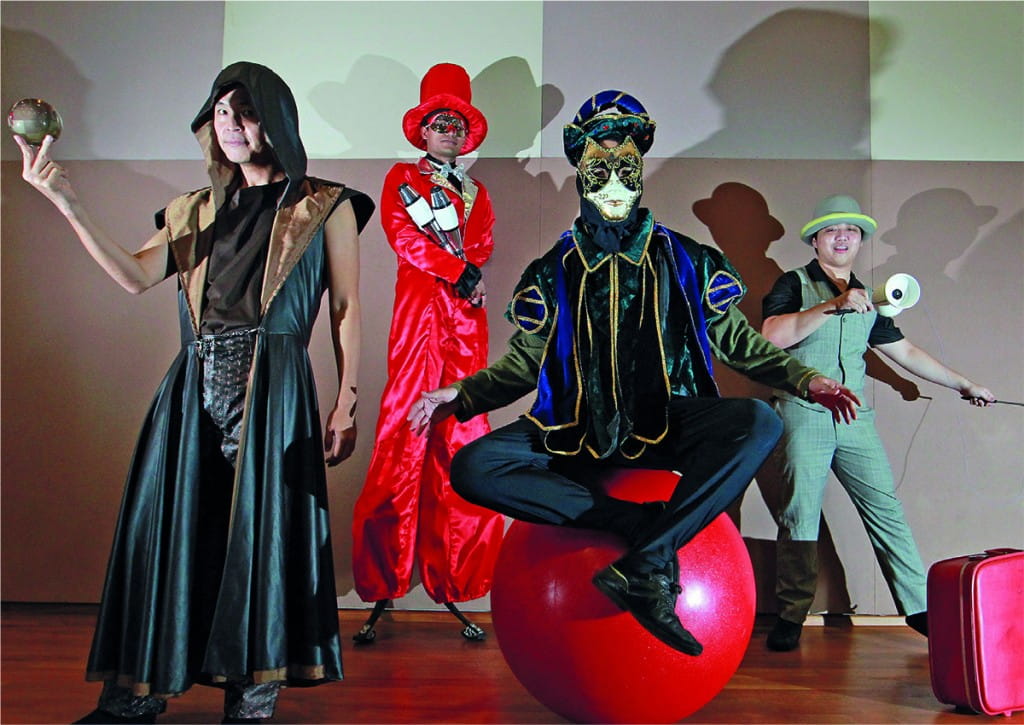
Circus in Motion, headed by Jay Che (far left, with CIM members), conducts circus workshops for youth-at-risk and special needs children.
In June 2014, CIM was invited to participate in the International Clown Mime Festival by South Korean arts entertainment company Small Theatre Dolce. CIM decided to put a local spin to its segment, presenting a uniquely Singaporean circus performance. There, CIM performed Tikam Tikam, named after a traditional Malay guessing game. The show was inspired by traditional Singaporean childhood games such as playing marbles and also carried a storyline about a group of friends taking a chance on a newcomer.
Taking its act overseas is a major milestone for the outfit, said Che. But apart from flying the Singapore flag, the team also gained a deeper appreciation of other cultures while interacting with their counterparts of other nationalities, and forged new friendships.
Che’s team discovered that both Singaporeans and Koreans share common traditional games. For example, people in both countries played with the chateh, as known by Singaporeans, or the jegichagi, to Koreans. This is a toy made of feathers glued to a small coin, which players had to keep suspended in mid-air by kicking it continuously.
Che also had many memorable experiences of the Koreans’ kindness. He says: “The Koreans worked hand in hand with us to stage the show; somehow it felt like that they become part of our CIM team.”
To Che and his team, the experience was a celebration of cross-cultural friendships, which brought people together to collaborate for good.
The troupe is looking to perform at similar festivals in Bangkok this year-end as well as exploring presenting a show in Edinburgh.
“We want to put Singapore on the (cultural) map. We’re proud to bring our Singapore brand of circus to the world”, says Che.
COLLABORATING FOR CHANGE
HITTING HIGH NOTES
ChildAid, an annual charity concert staged by children for children, was mooted by Singapore English dailies
The Straits Times and The Business Times in 2005. It features children singing, dancing and playing instruments to raise money for youth from financially challenged families.
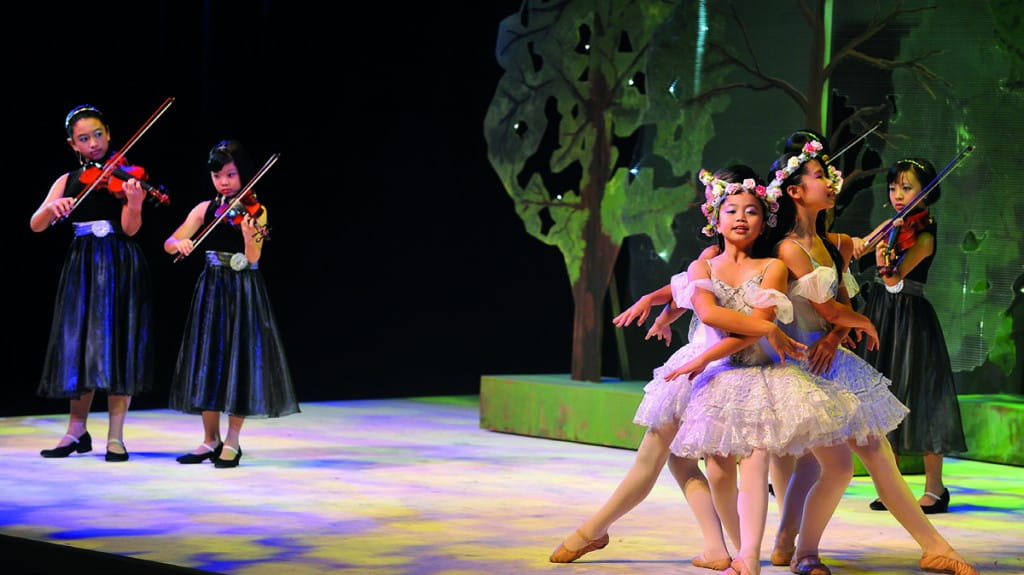
Graceful ballerinas from CHIJ (Kellock) String Ensemble dancing to a classical composition by Italian composer Antonio Vivaldi at a ChildAid Concert 2011.
At its 10th anniversary celebrations in December 2014, ChildAid saw over 200 children take to the stage, raising more than S$2.3 million. The money went to The Straits Times School Pocket Money Fund, which disburses money to children and youths for school expenses, and The Business Times Budding Artists Fund (BT BAF), which sponsors arts training for children and youth.
Music, dance, theatre and visual arts lessons are conducted at The Little Arts Academy, which has trained more than 9,000 youths since 2005, some of whom have given back by participating in ChildAid concerts and other fundraisers.
CULTURAL EXCHANGES IN JAPAN
The ChildAid series of concerts have been so well received in Singapore that a non-profit organisation in Japan, NPO Little Creators, has adopted the concept, resulting in ChildAid Asia. Four concerts have been staged in Tokyo since 2011 in aid of the Shakujii Gakuen orphanage.
At ChildAid Asia 2014, 130 children and youths from Singapore, Japan, Indonesia and Malaysia performed in Tokyo.
Co-organising Chairman Alvin Tay, who is also editor of The Business Times,
says the concerts in Japan foster international ties: “We have talented youths performing together and forming friendships with one another.”
Japanese performer Kanon Honda says: “I made many friends from other countries. Despite our different musical styles, the audience enjoyed the music.”
His sentiments are echoed by Singaporean Dineaish Rajendran, a ChildAid beneficiary. “When I first met my co-host Katsuki, I was shy and uncomfortable. However, during the rehearsals, we helped each other with our lines and became friends.”
Colin Goh, CEO of The RICE Company which manages The Little Arts Academy, says the youths exchanged stories about the challenges they faced to motivate one another during rehearsals. Through their experience, lifelong friendships were formed.
“We have talented youths performing together and forming friendships with one another.”
— Alvin Tay, Co-organising Chairman of ChildAid concerts
Singaporean Fadilah Amin, who performed at the 2013 concert, recalls: “When we met the children from the orphanage, we had problems communicating. But when we sang the finale song, Bridge Across the Sea, in English as well as Japanese, it felt like we spoke the same language.”
With the success of ChildAid, Kyoko Hasegawa established Little Creators to give back to Singapore. It was set up in Singapore in March 2014 to enhance cultural exchange programmes between the children and youth from the two countries. She also started Happy Pancakes Café — a social enterprise jointly run with RICE Company to provide job training and support to Singaporean youth from disadvantaged backgrounds.
Hasegawa credits the success of Little Creators to the unwavering support from her Singaporean friends Goh and the team from RICE Company, who have stood by her throughout this whole journey. She recounts with a smile that “this friendship is a treasure”.
The Founder and Director of Little Creators says the aim of ChildAid Asia is to build a strong friendship between Japan and Singapore “not only now but for the future”. She adds: “The long-lasting relationships fostered by the children through the concert will become the foundation for deeper relations between the two countries and will pave the way for peace in Asia in the future.”
ENGAGING COMMUNITIES
WORLD PHOTOGRAPHER
Self-taught Singaporean photojournalist Zann Huizhen Huang photographically documents humanitarian and socio-political issues in countries such as Bhutan, Laos and Myanmar.
She has been freelancing as a field editor and photographer in the Middle East for Asian Geographic magazine since 2006 but has also worked on personal projects to photograph the lives of people in that region as well as those of Southeast Asia.
PRIVILEGED ACCESS
Being a foreign woman allowed her to gain “exclusive access to witness a world in which male photojournalists may not be able to see”, for example, a stolen kiss between an unmarried couple in Iran and Iranian ladies in a beauty salon.
Huang explains: “I’ve been given access to areas where many women in the Middle East are forbidden such as an invitation to an all-male private alcohol party in a conservative neighbourhood in Iran.”
Exhibitions bring people of different communities together. In 2012, she held a photo exhibition, Iran-Unveiled, that gave many a glimpse into the lives of Iranians which might have remained unseen otherwise.
FRIENDS FOR 79 YEARS
In 2011, when Huang read about the impending closure of the Tanjong Pagar Railway Station, the terminus station of the train network operated by Malaysian railway Keretapi Tanah Melayu (KTM), she felt she had to chronicle the station’s last few weeks of operation in a photo documentary.
Titled Collective Memories: KTM 79, the photographs captured different facets of the historical Tanjong Pagar Railway Station — the people and their stories behind the iconic landmark and a friendship that dates back almost eight decades.
The railway station, which opened in 1932 and closed on 1 July 2011, held much historical and architectural significance and sentimental value for Singaporeans.
Many Singaporeans have fond memories built around this place — of friends sharing meals and laughter, friendships made and farewells bade as well as tales of cross-border romances.
To unearth these hidden memories, Huang went to the station about three times a week. “I interacted with the railway staff, the hawkers selling food there and the passengers. I noticed that emotions got more intense as the station’s closure drew nearer,” she recalls.
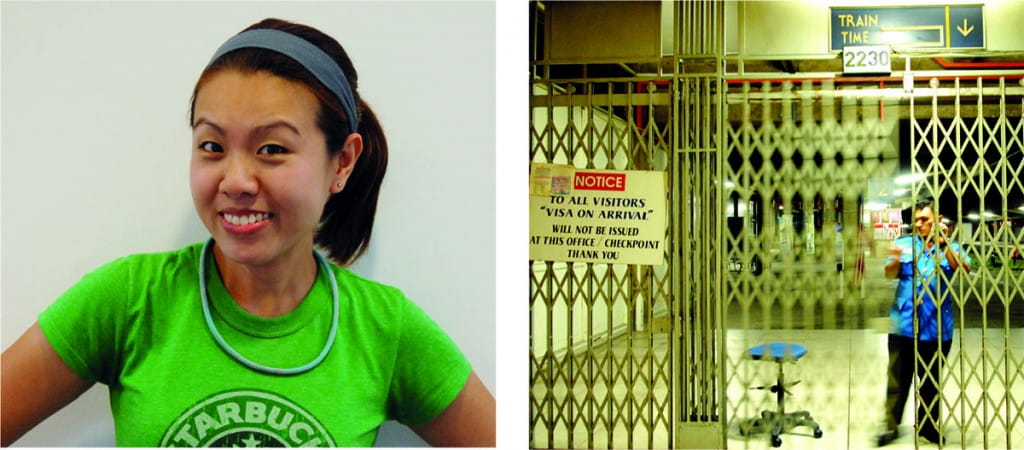
Self-taught photojournalist Zann Huizhen Huang (above left) captured many memorable moments at Tanjong Pagar Railway Station in a photo documentary before it closed on 1 July 2011.
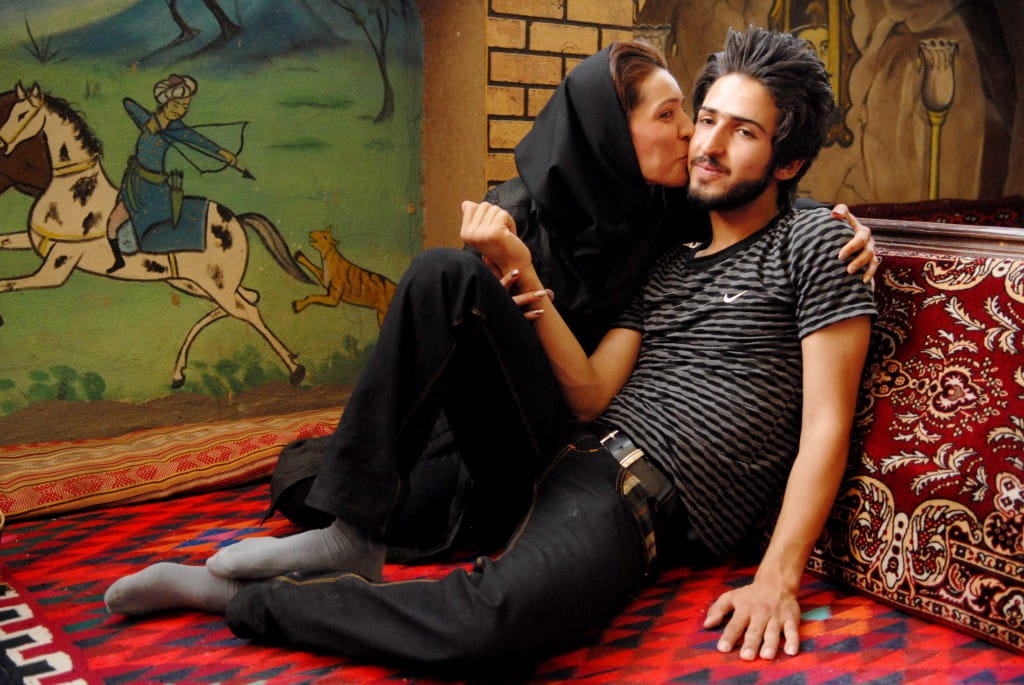
Zann Huang photographed an Iranian woman kissing her boyfriend, a rare scene because public affection in Iran is not common.
MOVING TRACKS INTO RAILWAY PHOTOS
To fully immerse herself in the experience of the railway, Huang spontaneously bought a ticket from Kuala Lumpur, Malaysia’s capital city, to Singapore.
Her train pulled out from the railway station at midnight. When dawn broke, the train was already in Singapore, and travelling through the “green corridor”, a rustic strip of land untouched by development.
“It was like a ‘time trap’,” says Huang. “This green corridor is unique because it’s a part of the country that has not been affected by rapid urbanisation. I feel it’s remarkable to have a stretch of Malaysian land running through Singapore like an umbilical cord. This reflects the very close ties between the two nations.”
